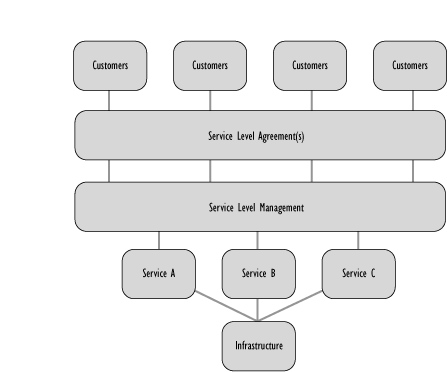4.1.1 Why Service Level Management?
4.1.2 Goal for SLM
4.1.3 Scope for SLM
4.1.4 Basic concept of SLM
Service Level Management (SLM) is essential in any organisation so that the level of IT Service needed to support the business can be determined, and monitoring can be initiated to identify whether the required service levels are being achieved - and if not, why not.
Service Level Agreements (SLA), which are managed through the SLM Process, provide specific targets against which the performance of the IT organisation can be judged.
The goal for SLM is to maintain and improve IT Service quality, through a constant cycle of agreeing, monitoring and reporting upon IT Service achievements and instigation of actions to eradicate poor service - in line with business or Cost justification. Through these methods, a better relationship between IT and its Customers can be developed.
SLAs should be established for all IT Services being provided. Underpinning contracts and Operational Level Agreements (OLAs) should also be in place with those suppliers (external and internal) upon who the delivery of service is dependent.
Service Level Management is the name given to the processes of planning, co-ordinating, drafting, agreeing, monitoring and reporting on SLAs, and the on-going review of service achievements to ensure that the required and cost-justifiable service quality is maintained and gradually improved. SLAs provide the basis for managing the relationship between the provider and the Customer.
When the first ITIL SLM book was published in 1989, very few organisations had SLAs in place. Today most organisations have introduced them - though with varying degrees of success. This Version includes some coverage of the common causes of failure, and guidance on how to overcome these difficulties.
A written agreement between an IT Service provider and the IT Customer(s), defining the key service targets and responsibilities of both parties. The emphasis must be on agreement and SLAs should not be used as a way of holding one side or the other to ransom. A true partnership should be developed between the IT provider and the Customer, so that a mutually beneficial agreement is reached, otherwise the SLA could quickly fall into disrepute and a culture of blame prevent any true service quality improvements from taking place.
Figure 4.1 outlines the normal Customer/Service Level Management relationship:

Figure 4.1 - Customer/Service Level Management Relationship
![]()
![]()